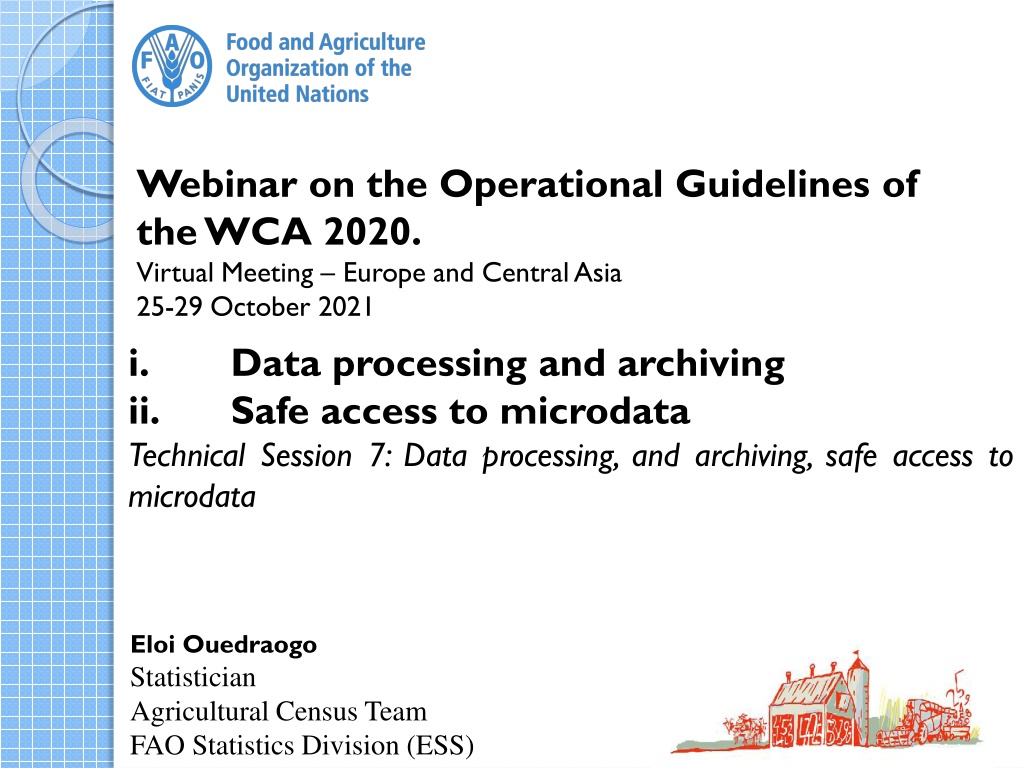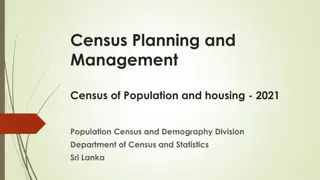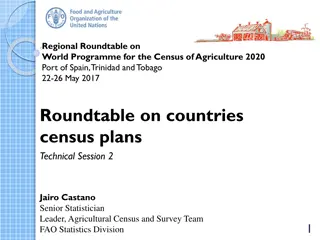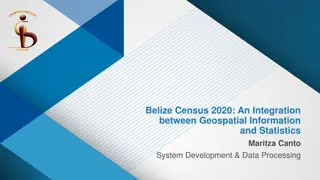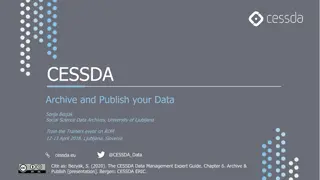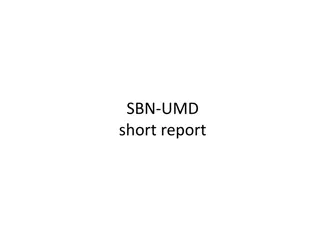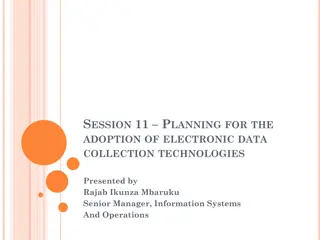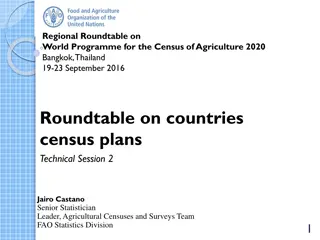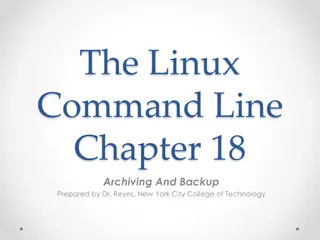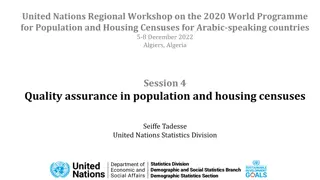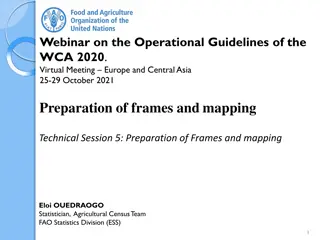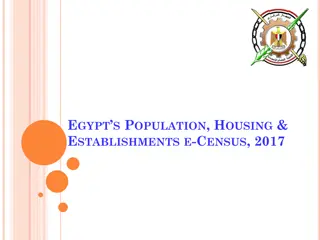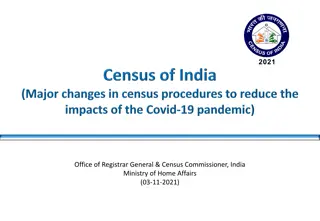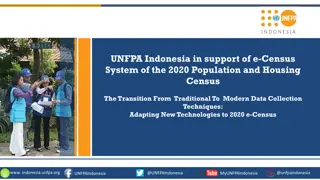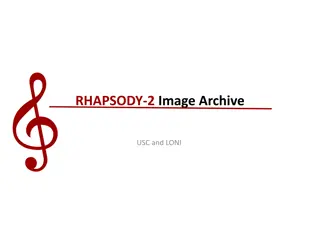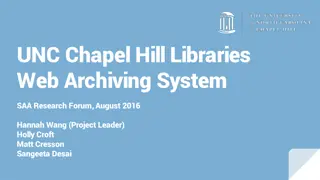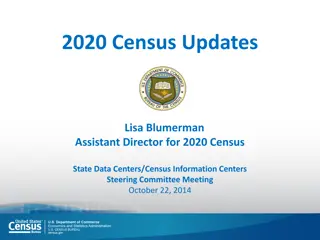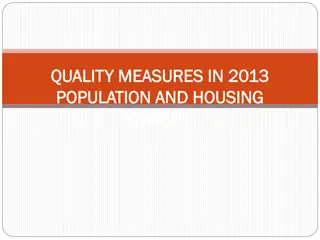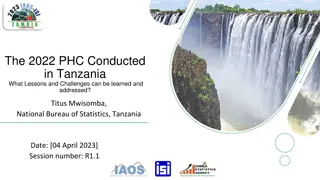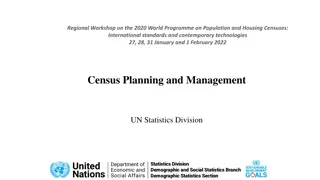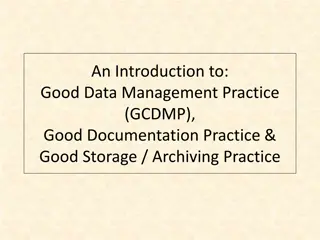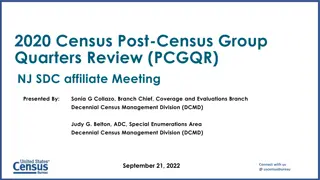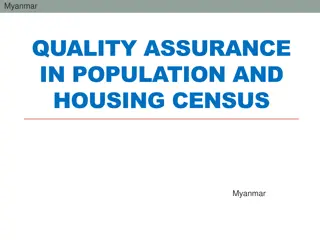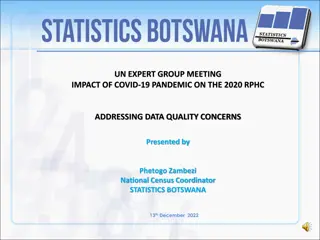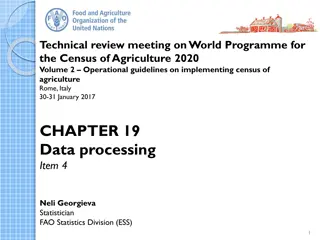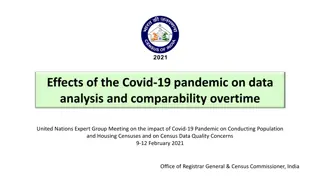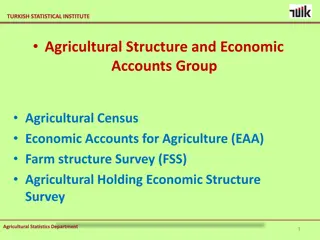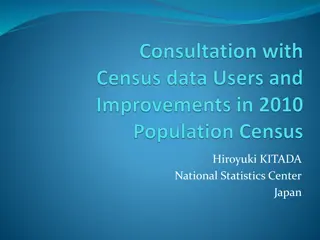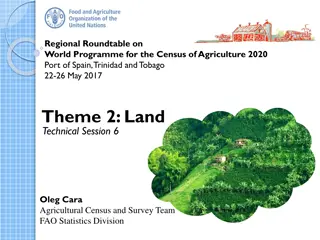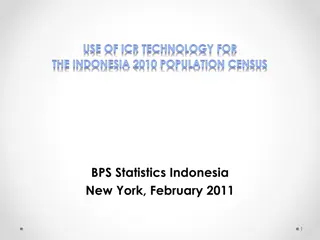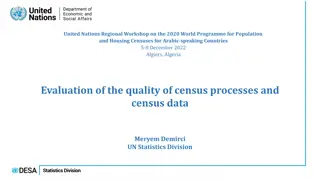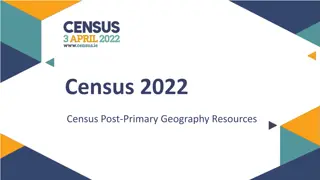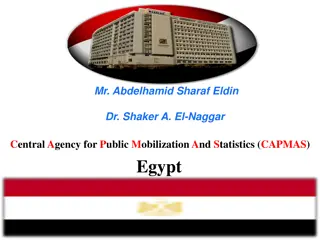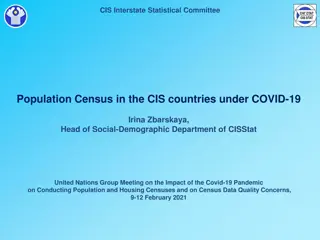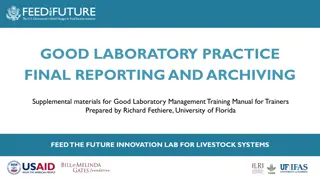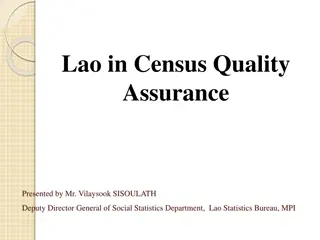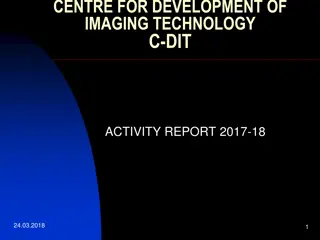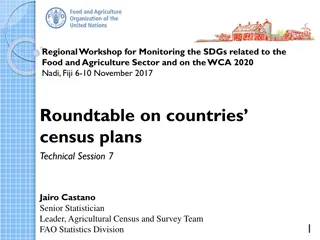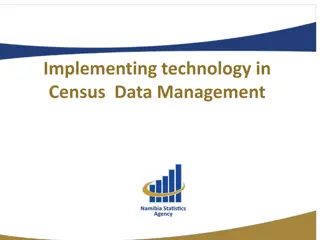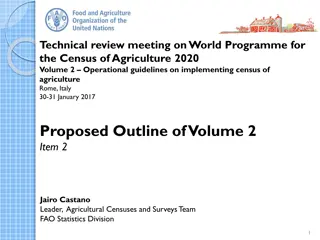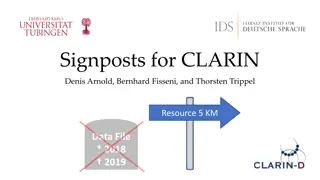Best Practices in Data Processing and Archiving for Agricultural Census
Explore the operational guidelines from the WCA 2020 Virtual Meeting focusing on data processing, archiving, and safe access to microdata. Learn about hardware and software requirements, data processing activities, good practices for data integrity, and ensuring safe access to microdata for agricultural census purposes.
Download Presentation

Please find below an Image/Link to download the presentation.
The content on the website is provided AS IS for your information and personal use only. It may not be sold, licensed, or shared on other websites without obtaining consent from the author. Download presentation by click this link. If you encounter any issues during the download, it is possible that the publisher has removed the file from their server.
E N D
Presentation Transcript
Webinar on the Operational Guidelines of the WCA 2020. Virtual Meeting Europe and Central Asia 25-29 October 2021 i. ii. Technical Session 7: Data processing, and archiving, safe access to microdata Data processing and archiving Safe access to microdata Eloi Ouedraogo Statistician Agricultural Census Team FAO Statistics Division (ESS) 1
CONTENT Ch 21: Data Processing Introduction Hardware and Software Testing computer programmes Data processing activities Data editing Imputation Data Validation and Tabulation Ch 21: Data Archiving Introduction Good Practices for Integrity Features of Digital Content Evaluation and audit Ch 22: Safe access to microdata What is microdata and why it is useful Metadata and Statistical Disclosure Types of access 1. 2. 3. 4. 5. 6. 7. 1. 2. 3. 1. 2. 2
Introduction Data processing includes data coding, entry, editing, imputation, validation and tabulation. Data processing depends on the country capacity in terms Communication Technology hardware, software including decisions on data collection method (e.g. PAPI or CAPI). of Information (ICT), and infrastructure, and i.e. 4
Hardware and Software The ICT strategy for the census should be part of the overall agricultural census strategy. It depends strongly on the data collection option and modality of census taking chosen. The decision needs to be made at early stage to allow sufficient time for testing and implementing the data processing system. Key management issues need to be addressed: Strategic decisions for the census program, often related to timing and cost; Existing technology infrastructure; Level of technical support available; Capacity of census agency staff; Technologies used in previous censuses; Establishing the viability of the technology; Cost-benefit. 5
Hardware and Software contd Hardware requirements Main characteristics of agricultural census data processing: large amounts of data to be entered in a short time with multi-users and parallel processing mode of servers; large amounts of data storage required; relatively simple transactions; relatively large numbers of tables to be prepared; extensive use of raw data files which need to be used simultaneously; method of data capture chosen by the census office. Basic hardware equipment: Many data entry devices (PCs, laptops, hand-held devices); Central processor/server and networks; Fast, high-resolution graphics printers. Software Allows for a smooth data processing; Use standard software maintained by the manufacturer (to allow for data portability). 6
Testing computer programmes Considerable computer programmes. Computer programmes prepared should be tested by verifying results of both error detection and tabulations for a group of 100-500 questionnaires (or less if qualified staff is not available). Data used for such tests should be tabulated manually to check classification in the tabulations. Pilot censuses give a good opportunity for final and comprehensive test of the computer systems and programmes, including the data transfer (in case of CAPI, CATI, CAWI). time is required to write each item or its 7
Data processing activities It covers: 1. Data coding and capture Data editing Imputation Validation and tabulation Calculation of sampling error and additional data analysis. 2. 3. 4. 5. 1. Data coding and capture Data coding: operation where original information from the paper-based questionnaire, as recorded by enumerators, is replaced by a numerical code required for processing: - Manual - Computer Data entry methods: Manual; Optical scanning; Optical Intelligent Character Reader (OICR) Handheld devices; Internet and computer-assisted telephone interviews (CAWI and CATI). Optical Mark Reader (OMR) 8
Data processing activities (contd) Manual data entry Time consuming Subject to human error More staff needed Rigorous verification procedure needed Simple software 9
Data processing activities contd Handheld device data entry Use of CAPI with electronic questionnaire, data entry completed directly by the enumerators: Cost-effective Allows for automatic coding and editing Allows for skip patterns Thorough testing of the data-entry application required: Functional testing Usability testing Data transfer testing. CAWI and CATI data entry Usually administered in conjunction with other methods Similar to handheld data collection - online form are used; an application guides the respondent through the questionnaire Testing the flow and skip patterns of the online form is essential. 10
Data editing Process involving the review and adjustment of collected data. Purpose: to control the quality of the collected data. The effect of editing questionnaires: to achieve consistency within the data and consistency within the tabulations (within and between tables); to detect and verify, correct or eliminate outliers. Manual data editing (when using PAPI) Verify the completeness of the questionnaire minimize the non-response. Should begin immediately after the data collection and close to the source of data. Very often errors are due to illegible handwriting. Have some advantages: identify paper-based questionnaires to be returned for completion; helps to detect poor enumeration. 11
Data editing contd Automated data editing Electronic correction of digital data. Efficient editing approach for censuses, in terms of costs, required resources and processing time. Checks the general credibility of the digital data with respect to missing data; range tests; and logical and/or numerical consistency. Two ways: interactively at the data entry stage: prompt error messages on the screen and may reject data unless they are corrected; useful for simple keying errors, but may greatly slow down the data entry process. Used with CAPI, CATI or CAWI data collection methods. batch processing: after data entry; consists of a review of many questionnaires in one batch. The result is usually a file with error messages. Used in all data collection modes. 12
Automated data editing contd Two categories of errors: critical - needs to be corrected; could even block further processing or data capture. non-critical - produce invalid or inconsistent results without interrupting the flow of subsequent processing phases; as many as possible to be corrected but avoiding over-editing. Data editing (data detection) applied at several levels: At item level, which is usually called range checking ; At questionnaire level (checks are done across related items of the questionnaire); Hierarchical that involves checking items in related sub-questionnaires. 13
3. Imputation The process of addressing the missing, invalid or inconsistent responses identified during editing on the basis of knowledge available. When used, a flag should be set. Two imputation techniques commonly used: (a) cold-deck imputation (static look-up tables) (b) hot-deck imputation (dynamic look-up tables) Can be done manually or automatically by computer: Aspects to be considered for automatic editing and imputation: the immediate goal in an agricultural census is to collect data of good quality. If only a few errors are discovered, any method of correcting them may be considered satisfactory; it is important to keep a record of the number of errors discovered and the corrective action (by kind of correction); non-response can always be tabulated as such in a separate column. redundancy of information collected in the questionnaire can be useful to help detect errors. 14
4. Data validation and tabulation 4a. Validation Should run parallel to the other processes. All data items should be checked for consistency and accuracy for all categories at different levels of geographic aggregation. Macro-edit - the process of check at aggregated level. Focuses analysis on errors which have impact on published data. Validating the data before it leaves the processing centre ensures that errors that are significant and considered important can be corrected in the final file. Final file - as the source database for the production of all dissemination products. 4b. Tabulation Very important part of the census; the most visible outcomes of the whole census operation and the most used output. 15
5. Calculation of sampling error and additional data analysis When sampling is used (e.g. for supplementary modules in the modular approach or the rotating modules in the integrated census and survey modality), expansion factors need to be computed and applied according to sample design. Data can be aggregated using estimation formulas and appropriate expansion factors. Data cannot be properly used and evaluated unless an indication of the sampling error is associated with the values obtained. 16
Country example: Canadas certification StatCanada has in place a certification committee (e.g. census managers and subject matter experts) that at the end of the validation process reviews and officially certifies the results (by geographic area). The information presented to the committee should: Anticipate the census results (forecast, other surveys, consultations with industry experts). Align the results with the current socio-economic context. Compare results with historical data, admin data, survey data and other correlated variables. Outline the impact of the processing and validation on the raw data. Recommend to the committee that data be: published; published with a cautionary note; deferred for more investigation before publication; or not published. 17
DATA ARCHIVING (RLG OCLC Report, RLG, Mountain View, CA May 2002) 18
Introduction Archiving of census material involves many aspects including technical documentation, programs, etc. The focus is on archiving census microdata files. Like other data, census data can hold cultural and institutional value far into the future. Therefore, it should be physically secured. It is always important to stress that there should be backup copies of data (both on-line and off-line) Data archiving should be fully mainstreamed in the census planning and budgeting process so that adequate actions are taken in time. Fortunately, digital preservation possible for census offices to manage digital data over the long-term. data files, IT standards make it 19
Good practices for integrity features of digital content (International Household Survey Network, IHSN, 2009) Integrity Feature Related Good Practice Content: elements preserved Fixity: content are recorded, ideally from the moment of creation onward ensures of that essential An agricultural census office is expected to explicitly identify and actively manage data to be preserved. At minimum, this feature might be addressed through routine use of a checksum to detect intentional or unintentional changes to data and notify data managers for action. For example, an agri-census office is required to adopt and maintain approach (assigning and identifiers that allows digital materials to be consistently and uniquely referred to over time). This feature requires that an agri-census office records information (captured as metadata) on the creation and action that have affected the content since its creation (e.g., data deposited in an archive, migrated from one format to another). An agricultural census office that preserves data should document relationships between its own digital content and, to the extent possible, to data managed by other organisations. digital content are requires that changes to Reference: uniquely and specifically identifiable in relation to other content across time ensures content is a persistent managing identifier enduring Provenance: requires digital content to be traceable to its origin (point of creation) or, at deposit in a trusted digital repository minimum, from Context: documents and manages relationships or digital content 20
Evaluation and Audit in data archiving A preservation self-evaluation checks the compliance with the community standards and helps census offices consider their digital assets in terms of scope, priorities, resources, and overall readiness to address digital preservation concerns. Next step, census offices can create their own preservation policy, reflecting the mandate of the organization to preserve data. Formal evaluations are available and recommended, including: Data Seal ofApproval; TDR Checklist - a rigorous ISO standard (16363); Digital Repository Audit Method Based on Risk Assessment (DRAMBORA). Ten principles for digital preservation repositories summarizes the core criteria for trustworthy repositories. 21
SAFE ACCESS TO MICRODATA (RLG OCLC Report, RLG, Mountain View, CA May 2002) 22
What is microdata and why is it useful? Microdata refers to the information that is recorded by or from the respondent when a survey or census is conducted. For the agricultural census this would correspond to the data collected for the holding. Each row in the microdata corresponds to a holding and each column to the data variables. In addition to the variable labels, data users need metadata which helps them understand the codes, definitions and concepts underpinning the data that were collected: what they measure and how they were created in order to understand the quality of the data. Microdata allows researcher to use the census or survey data to analyze questions which require a finer grained analysis than the original tabulations. 23
Agricultural microdata Particular characteristic: holdings fall within the definition of being enterprises or businesses because they are units of production. Disclosure control risks business data differ from those for household surveys: data of large commercial farms are often small-target populations difficult to anonymize. However, AC and survey data share characteristics with both household survey data and enterprise survey data. and techniques for and therefore more 24
Confidentiality and legal framework Confidentiality Meeting researchers needs, while ensuring the greatest protection for maintaining the privacy of the respondents, are prime considerations when choosing a microdata access system. Providing access to microdata requires that the statistical agencies balance demands from the research community with their legislated requirements to maintain confidentiality. Legal and policy frameworks The census agency must comply with the legal framework and charters under which it operates: to maintain respondent support and at the same time recognize that there are methods for ensuring confidentiality and making microdata available for statistical purposes. It is important to have clear policies on the actions that can be taken by the agency regarding census microdata access and that this information is available to the public in a transparent mode. 25
Disclosure Safeguarding confidentiality means that best attempts must be made to ensure that the file does not disclose suppressed data. A disclosure occurs when someone using a microdata file recognizes or learns something they did not previously know about a respondent in the census or when there is a possibility that a holding or individual in the holder s household be re-identified by an intruder using information contained in the file. There are two main ways in which disclosure can occur: Identify disclosure: when a direct identifier left in the file, (e.g., a name, telephone or address) from which the identity can be learned. Attribute disclosure: if an attribute or combination of attributes (e.g., a large commercial farm or type of rare crop) can be directly associated with a particular respondent. Persons with knowledge of the region could identify that person. Residual disclosure occurs when successive retrievals from a file can be compared (subtracted) to isolate a respondent s value. 26
Metadata and Statistical Disclosure Statistical Disclosure Control (SDC) SDC refers to confidentiality requirements that govern the work of the NSO are met and that the risk of revealing information about the respondent is minimal (i.e. anonymization). SDC risk is affected by many factors, including: The sensitivity of the data; The existence of outside sources of information or combinations of variables that can be used to re- identification of respondents; Ability to combine the released data with data from other publically available sources; Whether the microdata file is from a sample survey or a complete enumeration census. the process of ensuring that the 27
Statistical Disclosure Control (SDC) The SDC procedures generally involve: Removal of direct identifiers such as names, addresses, telephone numbers, detailed holdings. Removal of indirect identifiers such as detailed location of agricultural units. This includes geographic coordinates, location of sample segments, plot or segment locations whether recorded as attribute information or as part of an area frame sample. Application of anonymization techniques based on the disclosure risk identified. techniques and software to assist in anonymization are not discussed here but are widely available in the literature. Evaluation of the file for utility and information loss. location of agricultural Detailed technical details of 28
Types of access to microdata Public Use Files (PUFs): rigorous SDC process so that the chance of re-identification of respondents is minimal. Users to agree to certain conditions of use in a click through agreement. Licensed Files: also anonymized but with the possibility of fewer SDC procedures depending on the nature of the file and the policies of the producer. Remote Access Facilities (RAFs): it allows users to supply the algorithm they will be using in their analysis (in SAS, SPSS, STATA or R) using a synthetic file that replicates the structure and the content of the actual data sets. The NSO runs the algorithm against the actual data set and vet the results for disclosure before returning the output to the user. Data enclaves: consists of a facility within the premises of the NSO to which users can come in order to perform their research on detailed files. These files are the most detailed files available to the users other than the master file itself. Deemed Employee: possibility that the reseracher/user may be sworn in to work with the agency as a temporary staff member. 29
THANK YOU 30
